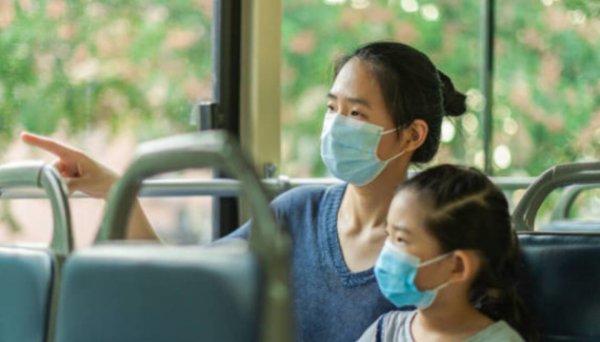The virus in the Middle Kingdom put tens of thousands of Beijing residents in hospital beds
The lack of sufficient information about the outbreak by the Chinese authorities has led to suspicions of a new epidemic threat. So early last week, Taiwanese authorities advised the elderly, the very young and those with immune problems to avoid traveling to the mainland, and towards the end of last week, a group of Republican senators led by Marco Rubio called on President Joe Biden to ban air travel with China altogether .
THE BEGINNING OF “UNDIAGNOSED PNEUMONIA”
The story of signs of a new epidemic began in late November with the publication of the authoritative disease monitoring program ProMed (abbreviated as Program for Monitoring Emerging Diseases), which tracks outbreaks of human and animal diseases around the world. So, on November 22, ProMed reported clusters of “undiagnosed pneumonia.” in children in Northern China.
It should be noted that it was ProMed's warning in December 2019 that brought attention to a new virus in China that later became known as SARS-CoV-2, which causes COVID-19. And earlier, at the beginning of 2003, ProMed also played a decisive role in the detection, again in the Middle Kingdom, of an outbreak of SARS with a high 11% fatality rate due to the SARS-CoV-1 virus.
The Taiwanese publication FTV News and the Hong Kong SCMP (South China Morning Post) were the first to report on a large number of cases of unknown pneumonia in children's hospitals in Beijing, Liaoning and other cities in northern China, publishing the corresponding photos. Mainland Chinese media have traditionally been in no hurry to “cause panic.” among readers, while local social networks “Uchat” are popular. and Weibo published photos and videos of overcrowded hospitals, long lines of adults with small patients in their arms, and panicked suspicions that the authorities were again hiding something very bad.
Photo: Getty Images
In the comments, the Chinese most often wrote: “A lot of children are hospitalized. They do not cough or have symptoms. They just have a high temperature and fever. Patients have to wait waiting in line for 2 hours, although doctors in emergency departments work around the clock.They also said that schools began to prohibit children with any signs of a cold from attending classes, and everything that happened was even called a “state secret.”
Against this backdrop, the World Health Organization (WHO) asked Beijing on November 22 to provide additional epidemiological and clinical information about a potentially alarming surge in respiratory illnesses and pneumonia in children in northern China. After a request from WHO, this topic, in fact, received wide publicity around the world.
Chinese authorities responded the next day and informed the organization that in the current outbreak, the reported symptoms were common to several respiratory diseases and were caused by known pathogens that people had been dealing with for a long time. No new pneumonia pathogens have been discovered, so there is no cause for concern, just a relatively large seasonal spike.
WHO accepted this response and stressed that it is closely monitoring the situation and is in close contact with the Chinese authorities.
>
VIRUSES AND ATYPICAL SIGNS
Conclusions of Chinese doctors and epidemiologists about the “usuality” of The current outbreak of respiratory diseases is based on the assertion that their main cause is influenza, and not only children, but also adults are sick. At the same time, children under 4 years old, in addition to the flu, suffer from a nasal virus, from 5 to 14 years old. mycoplasma pneumonia and adenovirus, adults – rhinovirus and coronavirus, and patients over the age of 60 years – metapneumovirus, also a respiratory disease. In other words, all known cases in China have been diagnosed and no new or unusual pathogens have been discovered.
Photo: Longhua Liao/Getty Images
Chinese experts assured that they were constantly monitoring the situation and back in May they recorded the beginning of an increase in outpatient and hospitalization treatment of children for mycoplasma pneumonia, a common respiratory pathogen that often causes childhood pneumonia. Added to this in October was a sharp surge in childhood illnesses caused by other pathogens, such as respiratory syncytial virus (RSV), adenovirus and influenza virus. However, the listed viral infections have long been known and respond well to treatment with antimicrobial and other drugs. So what is atypical this time?
The first sign is the speed of spread and scale. The surge occurred in the last days of November, when China recorded an average of about 7 thousand new patients per day. At that time, the Beijing Municipal Health Administration reported that in the capital, with a population (registered and unregistered) of more than 25 million, almost 72,500 cases were recorded in just one week from November 20 to 26, that is, more than 10 thousand daily.
The same situation occurred in other large cities in northern China. For example, a children's hospital in Beijing's neighboring municipality of Tianjin (population about 15 million) was reported by one of the local publications to operate around the clock, serving a record 13,000 patients daily in outpatient departments and emergency departments.
Chinese health experts believe that the main reason for the unusually high number of cases of respiratory diseases is the imposition of the effects of three years of strict quarantines due to COVID-19 on the seasonality factor. Only in December last year did China begin to gradually lift anti-corrosive restrictions, due to which children were forced to spend almost all their time at home with their families and were deprived of the opportunity to strengthen their immunity.
Doctors identified another sign of atypicality during the treatment of patients, when they discovered bacterial resistance to macrolides – groups of antibiotics usually effectively treat respiratory diseases caused by mycobacterial infections, the causative agents of mycoplasma pneumonia. Bacterial infections are usually accompanied by mild respiratory symptoms, but this time Chinese experts and officials said the outbreak was particularly serious.
Experts in mainland China have long been warning about mycoplasma pneumonia resistant to macrolides. Back in 2013, scientists from the Chinese Center for Disease Control and Prevention noted that, likely due to frequent use of antibiotic-based drugs, the rate of resistance (antibiotic resistance) among patients in Beijing was higher than in the rest of the country, which significantly increases risks of severe disease in both adults and their children.
WHO: NO THREAT OF EPIDEMIC
However, some atypical signs of the current season of respiratory diseases do not change virologists' conclusion about the absence of so-called mysterious pneumonia, which could provoke a new epidemic.
<img title=""Undiagnosed pneumonia: what we know about the respiratory outbreak in China" No new infectious diseases caused by new viruses or bacteria have been discovered this winter, and all acute respiratory illnesses now reported in the country are caused by known pathogens , – Speaker of the National Health Commission of the People's Republic of China Mi Feng said at a press conference on December 2.
The head of the Chinese Influenza Center, Wang Dayan, then noted that influenza viruses are subject to mutations, and this can create certain problems for its prevention and treatment.

“The results showed that the antiviral drugs now used for treatment are effective against current influenza viruses,” – Wang said. According to her, Chinese scientists are working closely with laboratories and colleagues from different countries to find ways to counteract the decrease in the sensitivity of influenza viruses to antiviral drugs.
Wang said the dominant influenza virus subtypes in China this winter are influenza A (H3N2) and influenza B, which are unchanged from last year, and they also correspond to the dominant strains circulating in most countries around the world, and advised getting vaccinated to prevent severe cases.
«Vaccination can effectively reduce the risk of infection, disease and severe complications», – the virologist emphasized.
WHO gives similar conclusions and advice. Organization spokeswoman Margaret Harris said they consider the surge in mycoplasma pneumonia among children in China to be normal during the winter and do not see a threat of a new pandemic.
After reviewing the information provided by China, WHO does not propose strict quarantine measures and recommends that Chinese residents get vaccinated against influenza, COVID-19 and other respiratory pathogens, keep a distance from sick people, stay home when sick, wear masks and wash their hands regularly. WHO also advises those planning a trip to the Middle Kingdom to undergo antiviral vaccination, avoid crowds, wear a mask and wash their hands.
Is this WHO assessment of events in China justified? Probably, since, in addition to the authority of the international organization, whose conclusions a priori must be trusted, this year an excess of the epidemiological threshold of respiratory diseases was detected in other countries and in some regions of Ukraine.
For example, the Danish Statens Serum Institute, Infectious disease monitor reported on November 29 that infection with mycoplasma pneumonia in the country had reached epidemic levels, noting that the increase in incidence began in August, and at the end of November there was a sharp jump. Also, an outbreak of mycoplasma pneumonia was recorded in France, where the majority of patients are children.
It seems that this year we are really talking about an unusually sharp surge in respiratory infections throughout the world, caused by a confluence of several factors, and there is no reason to fear a new epidemic . In any case, you need to be attentive yourself, take care of your own immunity, follow the advice of doctors and take the necessary preventive measures in a timely manner.
Vladimir Sidorenko, Beijing</
First photo: Getty Images






